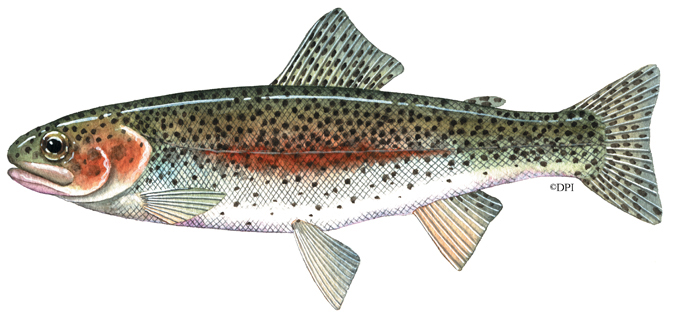Rainbow trout

| Common Name: | Rainbow trout |
| Other Name/s: | Steelhead trout |
| Family: | Salmonidae |
| Scientific Name: | Oncorynchus mykiss (Richardson, 1836) |
| Origin: | Introduced |
| The classification of "introduced" reflects its translocation to Australia and Victoria, and this category is noted in the Flora and Fauna Guarantee Act 1988 (introduced to Australia after 1788 AD). | |
Description
Upper body colour varies from olive-green to steely-blue, sides are lighter and the belly usually silvery-white. The head and body are heavily marked with small black spots, which are most numerous on the upper body. Top and tail fins are also heavily spotted. There is often a pink, red or orange flash along the head and sides of the body. The adipose fin is large. Body colouration increases at spawning when the pink/red/orange stripe becomes deep crimson and the lower fins often become reddish. Lower body becomes grey and body spots become more conspicuous.
Distribution
Streams and lakes throughout Victoria, in many cases as self-supporting populations where suitable habitat exists. Some lake and reservoir populations are maintained by regular releases of hatchery-produced fish.
Habitat
Usually requires cool, well aerated water, typically in rivers and streams with fast flows and gravel bottoms, and in deep lakes and impoundments. Usually more successful in lakes than rivers. Optimum water temperature range is 10-22°C; lower critical range 0-9°C, upper critical range 22-30°C.
Brief Biology
Known to attain 1.2 metres in length and 18 kg in its native North American habitat (western coast), best specimens in Australia reach 70 cm and about 9 kg. Generally fish larger than 60 cm and 5 kg are uncommon.
Carnivorous, with young fish eating mainly aquatic and terrestrial invertebrates with worms, molluscs and crustaceans also being taken. Adults feed on small forage fish.
Males and females usually mature at 3 years of age, and males develop a distinctive upward hook on the lower jaw. Breeding season is generally winter and early spring, but spawning is known to occur in some Victorian streams as early as May and as late as October.
Females produce about 1,500 eggs per kg of body weight. Eggs are laid in gravel substrate in flowing water having relatively high dissolved oxygen levels. Hatching occurs in 3 to 12 weeks depending on water temperature. Growth rate varies considerably depending on water type and conditions and food supply.
Three-year-old fish of 275-325 g have been found in some Victorian streams due to fish numbers exceeding available food, while fish of the same age in some Victorian lakes have weighed 2.5-4 kg reflecting better conditions and abundant food.
Management
The rainbow trout fishery in Victoria is roughly divided into two parts. The eastern half of Victoria has mainly self-supporting populations which exist where suitable habitat is available, while most suitable waters in the western half of the State depend on stocking with hatchery-produced fish - in most cases stocked waters are lakes or reservoirs.
Other Notes
Native to the western coastal drainages of North America from Mexico to Alaska. Introduced to Australia in 1894. Where rainbow trout and brown trout occur together, the brown trout usually dominates.
Hatchery-produced rainbow trout are rarely stocked in waters with easy access to the sea.
Faster growing fish than brown trout in most circumstances, but growth rate varies according to habitat and food supply. Lake Purrumbete in south-western Victoria once held the World record for growth, yearling fish reaching 1.4 kg, three-year-old fish reaching 8.4 kg.
These growth rates were exceptional and no longer occur partly because of the highly competitive and increasingly abundant redfin population in the lake (direct competition for food and space); partly because the very fast-growing populations were produced from stocking rates much lower than are now released; and partly because the productivity of the lake has declined markedly in the last 30 years and galaxiids which were the staple diet of rainbow trout in the lake no longer occur in as large numbers as formerly.
An excellent angling fish, which is also considered highly for its table qualities. Reputed to be more easily caught than brown trout. Flesh colour varies from orange-red to pink and white, depending on diet.
Regulations
Recreational Fishing Licence requirements, and regulations affecting the taking of Rainbow trout are available in the Victorian Recreational Fishing Guide, available free from Recreational Fishing Licence sales agents and DEDJTR Offices and Information Centres.
Further Reading
- A Guide to the Freshwater Fish of Victoria, Phillip Cadwallader & Gary Backhouse, Department of Conservation and Environment.
- Australian Freshwater Fishes, John R. Merrick & Gunther E. Schmida.
- Salmon at the Antipodes, John Clements.

